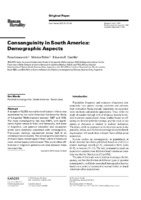Please use this identifier to cite or link to this item:
http://sgc.anlis.gob.ar/handle/123456789/469| DC Field | Value | Language |
|---|---|---|
| dc.contributor.author | Liascovich, Rosa | |
| dc.contributor.author | Rittler, Mónica | |
| dc.contributor.author | Castilla, Eduardo E. | |
| dc.date.accessioned | 2013-04-03T01:55:22Z | |
| dc.date.available | 2013-04-03T01:55:22Z | |
| dc.date.issued | 2001 | |
| dc.identifier.uri | http://sgc.anlis.gob.ar/handle/123456789/469 | |
| dc.description | A sample of 53,552 nonmalformed liveborn infants was ascertained by the Latin-American Collaborative Study of Congenital Malformations between 1967 and 1996. The mean consanguinity rate was 0.96%, with significantly higher values in Brazil and Venezuela, and lower in Argentina. Low paternal education and occupation levels were positively associated with consanguinity. First-cousin matings represented almost half of all consanguineous couples. The consanguinity was mainly of more closely related types in Brazil, while in Venezuela more remote types predominated. This could reflect differences in migration patterns and rates between these two countries. | en_US |
| dc.rights | restrictedAccess | en_US |
| dc.source | Human Heredity, 2001, 51(1-2), 27-34. | en_US |
| dc.title | Consanguinity in South America: demographic aspects | en_US |
| item.fulltext | With Fulltext | - |
| item.grantfulltext | open | - |
| crisitem.author.dept | Centro Nacional de Genética Médica (CeNaGeM) | - |
| crisitem.author.dept | Registro Nacional de Anomalías Congénitas (RENAC) | - |
| crisitem.author.parentorg | Administración Nacional de Laboratorios e Institutos de Salud “Dr. Carlos G. Malbrán” (ANLIS) | - |
| crisitem.author.parentorg | Instituto Nacional de Epidemiología (INE) | - |
| Appears in Collections: | Preproducción Publicaciones CeNaGeM | |
Files in This Item:
| File | Description | Size | Format | |
|---|---|---|---|---|
| HumanHeredity,2001,51(1-2),27-34..pdf | 168.35 kB | Adobe PDF |  View/Open |
Page view(s)
172
checked on Dec 14, 2025
Download(s)
108
checked on Dec 14, 2025
Google ScholarTM
Check
Items in DSpace are protected by copyright, with all rights reserved, unless otherwise indicated.

